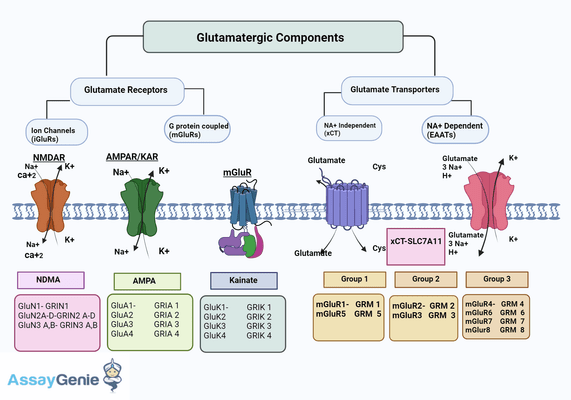Understanding Glutamate Receptors: Classification, Function, and Implications in Neurological Disorders
Glutamate receptors are pivotal in mediating excitatory neurotransmission in the central nervous system (CNS), playing crucial roles in synaptic transmission, plasticity, learning, and memory. These receptors are classified into two main categories: ionotropic glutamate receptors (iGluRs) and metabotropic glutamate receptors (mGluRs), each with distinct subtypes, signaling mechanisms, and functional roles. This article delves into the classification of glutamate receptors, their functional roles within the CNS, the intricate signaling pathways they mediate, mechanisms regulating their activity, and their involvement in various neurological disorders.
Types of Glutamate Receptors
Glutamate receptors are the gatekeepers of excitatory neurotransmission in the brain, classified based on their mechanism of action and response to specific agonists. Ionotropic receptors, which include NMDA, AMPA, and Kainate receptors, function as ligand-gated ion channels, while metabotropic receptors (mGluRs) act through G-protein-coupled receptor mechanisms to modulate neuronal and synaptic function indirectly.
Table 1: Classification of Glutamate Receptors
| Receptor Type | Subtypes | Ionotropic/Metabotropic | Function |
| NMDA | NR1, NR2A-D | Ionotropic | Mediate synaptic plasticity and memory formation |
| AMPA | Ionotropic | Fast synaptic transmission in the CNS | |
| Kainate | GluR5-7, KA1-2 | Ionotropic | Modulate neurotransmitter release and synaptic plasticity |
| Group I (mGluR1, mGluR5) | Metabotropic | Regulation of neuronal excitability and synaptic plasticity | |
| Group II (mGluR2, mGluR3) | Metabotropic | Modulation of neurotransmission and neuroprotection | |
| Group III (mGluR4, mGluR6-8) | Metabotropic | Presynaptic inhibition of neurotransmitter release |
Functional Roles of Glutamate Receptors in the CNS
Glutamate receptors are integral to the CNS's functionality, influencing aspects such as learning, memory, and synaptic plasticity. They are also implicated in various neuropathological conditions, offering potential therapeutic targets.
Table 2: Functional Roles of Glutamate Receptors
| Receptor Type | Role in CNS | Associated Disorders |
| NMDA | Learning, Memory, Synaptic Plasticity | Alzheimer's Disease, Depression, Schizophrenia |
| AMPA | Rapid Excitatory Synaptic Transmission | Epilepsy, Cognitive Disorders |
| Kainate | Modulatory Effects on Synaptic Transmission | Epilepsy, Neuropathic Pain |
| mGluR | Neurotransmitter Release, Synaptic Plasticity | Anxiety, Depression, Schizophrenia |
Glutamate Receptor Signaling Pathways
Activation of glutamate receptors triggers a cascade of intracellular signaling pathways, leading to various biological outcomes, including changes in synaptic strength, which are fundamental to learning and memory processes.
Table 3: Signaling Pathways Mediated by Glutamate Receptors
| Receptor Type | Signaling Pathway | Biological Outcome |
| NMDA | Activation of Ca2+/calmodulin-dependent kinase II | Long-term potentiation, Memory formation |
| AMPA | Activation of Protein Kinase A | Increase in synaptic strength |
| Kainate | Phospholipase C activation | Modulation of synaptic transmission |
| mGluR | Activation of G-proteins, IP3/DAG pathway | Neuroprotection, Synaptic modulation |
Regulation of Glutamate Receptors
The functionality of glutamate receptors is tightly regulated by various mechanisms, including phosphorylation, trafficking, and interaction with scaffolding proteins, ensuring precise control over excitatory neurotransmission.
Table 4: Mechanisms of Glutamate Receptor Regulation
| Mechanism | Receptor Type | Effect on Function |
| Phosphorylation | NMDA, AMPA | Alters channel properties, modulates synaptic strength |
| Trafficking | NMDA, AMPA, Kainate | Regulates receptor density at synaptic sites |
| Ligand Binding | mGluR | Modifies neurotransmitter release, neuronal excitability |
The Role of Glutamate Receptors in Neurological Disorders
Therapeutic Potential and Challenges
Conclusion
References
- Traynelis, S.F., Wollmuth, L.P., McBain, C.J., et al. (2010). Glutamate receptor ion channels: structure, regulation, and function. Pharmacological Reviews, 62(3), 405-496.
- Paoletti, P., Bellone, C., & Zhou, Q. (2013). NMDA receptor subunit diversity: impact on receptor properties, synaptic plasticity and disease. Nature Reviews Neuroscience, 14(6), 383-400.
- Collingridge, G.L., Olsen, R.W., Peters, J., & Spedding, M. (2009). A nomenclature for ligand-gated ion channels. Neuropharmacology, 56(1), 2-5.
- Lüscher, C., & Huber, K.M. (2010). Group 1 mGluR-dependent synaptic long-term depression: mechanisms and implications for circuitry and disease. Neuron, 65(4), 445-459.
- Nicoletti, F., Bockaert, J., Collingridge, G.L., et al. (2011). Metabotropic glutamate receptors: From the workbench to the bedside. Neuropharmacology, 60(7-8), 1017-1041.
- Lau, C.G., & Zukin, R.S. (2007). NMDA receptor trafficking in synaptic plasticity and neuropsychiatric disorders. Nature Reviews Neuroscience, 8(6), 413-426.
- Newcomer, J.W., & Krystal, J.H. (2001). NMDA receptor regulation of memory and behavior in humans. Hippocampus, 11(5), 529-542.
- Dingledine, R., Borges, K., Bowie, D., & Traynelis, S.F. (1999). The glutamate receptor ion channels. Pharmacological Reviews, 51(1), 7-61.
Written by Tehreem Ali
Tehreem Ali completed her MS in Bioinformatics and conducted her research work at the IOMM lab at GCUF, Pakistan.
Recent Posts
-
Metabolic Exhaustion: How Mitochondrial Dysfunction Sabotages CAR-T Cell Therapy in Solid Tumors
Imagine engineering a patient's own immune cells into precision-guided missiles against cancer—cells …8th Dec 2025 -
The Powerhouse of Immunity: How Mitochondrial Fitness Fuels the Fight Against Cancer
Why do powerful cancer immunotherapies work wonders for some patients but fail for others? The answe …5th Dec 2025 -
How Cancer Cells Hijack Immune Defenses Through Mitochondrial Transfer
Imagine a battlefield where the enemy doesn't just hide from soldiers—it actively sabotages their we …5th Dec 2025




